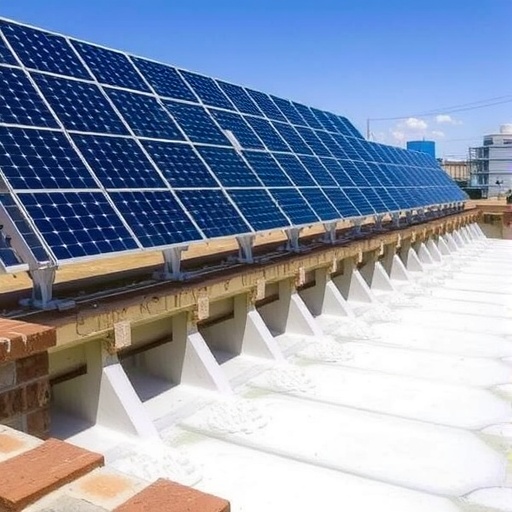In recent years, the global concerns surrounding wastewater management have become increasingly pressing, particularly for industries known for their environmental impacts. Tannery operations, in particular, generate substantial amounts of wastewater laden with toxic pollutants and harmful substances, prompting a search for effective and sustainable treatment methods. Groundbreaking research conducted by Verma and Kumar has shed light on a promising solution—solar-powered electrocoagulation treatment utilizing rotating electrodes made of aluminum and iron.
The study, published in Environmental Science and Pollution Research, delves into the performance evaluation of this innovative system, examining the potential benefits it holds for the treatment of tannery wastewater. Electrocoagulation, a process commonly employed to remove contaminants from water, involves the destabilization of pollutants through the generation of coagulants. This method has gained traction for its effectiveness, and when combined with renewable energy sources like solar power, it paves the way for not only efficiency but also environmental sustainability.
At the core of the study is a systematic exploration of the electrocoagulation process, through which Verma and Kumar harness the advantages of rotating electrodes made from aluminum and iron. The use of rotating electrodes is particularly noteworthy; as they improve mass transfer and enhance the mixing of wastewater, leading to increased removal rates of harmful pollutants. This novel approach not only optimizes treatment efficiency but also minimizes energy consumption, thereby aligning with sustainability goals.
The researchers employed response surface methodology to optimize various operational parameters, ensuring that they achieve maximum efficiency in contaminant removal. This comprehensive analysis allows for the fine-tuning of critical factors such as electrode material, current density, and wastewater characteristics. By systematically adjusting these parameters, they found optimal conditions under which the electrocoagulation system operates most effectively, making significant strides toward scalability and feasibility for industrial application.
Throughout the study, Verma and Kumar highlighted the kinetics of pollutant removal, examining how quickly specific contaminants could be treated under different conditions. Understanding the rates at which pollutants are removed is crucial for developing time-efficient treatment processes that can be implemented in real-world scenarios. With faster removal rates, tannery operations could integrate these systems into their workflow seamlessly, reducing downtime and enhancing overall productivity.
Moreover, the researchers explored equilibrium isotherms, providing insights into how contaminants interact within the electrocoagulation system. The findings reveal how different pollutants bind with coagulants over time, critical for predicting long-term treatment success. This data can guide future research in refining electrocoagulation approaches, further bolstering their effectiveness in treating not only tannery wastewater but potentially other industrial effluents as well.
Equally important to the technical advancements presented in the study is an analysis of the economic feasibility of implementing solar-powered electrocoagulation in tannery operations. While the initial investment in such technology may appear steep, the long-term savings from reduced energy consumption and improved wastewater management could provide remarkable financial returns. This is particularly enticing for the tanning industry, where compliance with environmental regulations is paramount and non-compliance can result in substantial penalties.
Verma and Kumar’s research also touches on the broader implications of utilizing solar energy in industrial processes. As the world shifts towards sustainable practices, integrating renewable energy sources like solar power into wastewater treatment signifies a pivotal move not just towards regulatory compliance, but also towards corporate social responsibility. By utilizing such technologies, industries not only mitigate their environmental footprint but also promote a positive image among consumers increasingly concerned with sustainability.
The implications of this research extend beyond just the tanning industry. Industries of all types face similar challenges in wastewater management. The methodologies and findings from this study provide a roadmap for others looking to ameliorate their waste disposal processes. As the principles of electrocoagulation and the innovation of rotating electrodes gain traction, we could witness an industry-wide transformation in how industrial wastewater is treated.
In summary, the research conducted by Verma and Kumar represents a significant leap forward in the treatment of tannery wastewater. The combination of solar power, advanced electrode technology, and optimization strategies positions this electrocoagulation method as a frontrunner for sustainable industrial wastewater treatment. As regulatory pressures increase and environmental responsibilities become a priority, such innovations are vital in shaping a more sustainable future for industries reliant on water use.
The foresight demonstrated in this study may inspire future research directions, promoting further exploration into alternative coagulant materials, the scalability of systems, and potential integration with other treatment methods. In doing so, Verma and Kumar not only address the immediate challenges of tannery wastewater but also contribute to the larger discourse on sustainable industrial practices that ensure the health of our planet.
This revolutionary approach to wastewater treatment exemplifies the convergence of technology and sustainability in the industrial sector, setting the stage for more ecological practices moving forward. The findings will resonate across various disciplines and industries, urging stakeholders to reconsider their wastewater treatment methods and invest in greener technologies for a cleaner, more sustainable future.
Subject of Research: Solar-powered electrocoagulation treatment of tannery wastewater
Article Title: Performance evaluation of a solar-powered electrocoagulation treatment of tannery wastewater with rotating electrodes of aluminum and iron: response surface methodology optimization, equilibrium isotherms, kinetics, and economic feasibility.
Article References:
Verma, R.K., Kumar, S. Performance evaluation of a solar-powered electrocoagulation treatment of tannery wastewater with rotating electrodes of aluminum and iron: response surface methodology optimization, equilibrium isotherms, kinetics, and economic feasibility. Environ Sci Pollut Res (2025). https://doi.org/10.1007/s11356-025-37153-1
Image Credits: AI Generated
DOI: https://doi.org/10.1007/s11356-025-37153-1
Keywords: waste management, electrocoagulation, solar energy, tannery wastewater, sustainable treatment, environmental sustainability, renewable technology




